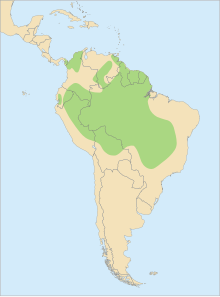Blue-and-gold macaw
| Blue-and-yellow macaw | |
|---|---|
 |
|
| At Jurong Bird Park | |
| Scientific classification | |
| Kingdom: | Animalia |
| Phylum: | Chordata |
| Class: | Aves |
| Order: | Psittaciformes |
| Superfamily: | Psittacoidea |
| Family: | Psittacidae |
| Subfamily: | Arinae |
| Tribe: | Arini |
| Genus: | Ara |
| Species: | A. ararauna |
| Binomial name | |
|
Ara ararauna (Linnaeus, 1758) |
|
 |
|
|
Distribution
|
|
The blue-and-yellow macaw (Ara ararauna), also known as the blue-and-gold macaw, is a large South American parrot with blue top parts and yellow under parts. It is a member of the large group of neotropical parrots known as macaws. It inhabits forest (especially varzea, but also in open sections of terra firme or unflooded forest) and woodland of tropical South America. They are popular in aviculture because of their striking color, ability to talk, ready availability in the marketplace, and close bonding to humans.
The blue-and-yellow macaw (Ara ararauna, Linnaeus 1758) is a member of the genus Ara (Lacepede 1799), one of six genera of Central and South American macaws. The species name is derived from Tupi ara onamatopoeia macao: macaw; Tupi arara: parrot +una: dark or black, hence "dark parrot/macaw".
These birds can reach a length of 76–86 cm (30–34 in) and weigh 0.900–1.5 kg (2–3 lb), making them some of the larger members of their family. They are vivid in appearance with blue wings and tail, dark-blue chin, golden under parts, and a green forehead. Their beaks are black. The naked face is white, turning pink in excited birds, and lined with small, black feathers. Blue-and-yellow macaws live from 30 to 35 years in the wild and reach sexual maturity between the ages of 3 and 6 years.
Little variation in plumage is seen across the range. Some birds have a more orange or "butterscotch" underside color, particularly on the breast. This was often seen in Trinidad birds and others of the Caribbean area. The blue-and-yellow macaw uses its powerful beak for breaking nutshells, and for climbing up and hanging from trees.
This species occurs in Venezuela, Peru, Brazil, Bolivia, and Paraguay. The range extends slightly into Central America, where it is restricted to Panama. The species' range formerly included Trinidad, but it became extinct there by 1970 as a result of human activities. Between 1999 and 2003, wild-caught blue-and-gold macaws were translocated from Guyana to Trinidad, in an attempt to re-establish the species in a protected area around Nariva swamp. A small breeding population descended from introduced birds is found in Puerto Rico, and another has inhabited Miami-Dade County, Florida, since the mid-1980s.
...
Wikipedia

